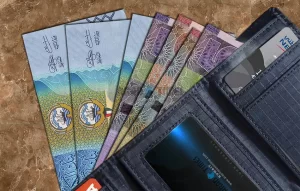70% of people in Kuwait are foreigners. Only slightly more than one million of the nation’s around 4.5 million inhabitants are native Kuwaitis, while almost two million are expatriates from other Asian nations. Kuwait’s population “quirk” is that men outweigh women in this age range by almost two to one.
The Kuwaiti dinar was rated as the world’s most valuable currency by rating website fxssi.com in November 2022 due to both its stability and the fact that it traded at a rate of 3.27 USD to 1 dinar.
What Is the Kuwaiti Dinar, or KWD?
The official money of the State of Kuwait is the Kuwaiti Dinar (KWD). Roman denarius is where the name dinar originated. Many Arab nations utilize the KWD, which is divided into 1000 fils.
On the Persian Gulf, Kuwait is a tiny country sandwiched between Saudi Arabia and Iraq. In terms of GDP per capita, it is one of the richest countries in the world due to its economy’s reliance on oil.
An overview of Kuwait’s history and the Kuwaiti dinar
The Kuwaiti Currency Board was established in 1960, the same year the Kuwaiti dinar was first used. The Gulf rupee, the official currency used in Kuwait and other British Protectorates situated in the Arabian Peninsula, was replaced by the dinar after the State of Kuwait attained independence in 1961 and ceased to be a British Protectorate.
When the Ottoman Empire endangered Kuwait’s independence, the country was made a British Protectorate in 1899. More than a century ago, the British East India Company established a presence in Kuwait after realizing the country’s strategic location in relation to the main maritime lanes linking important ports in Africa, India, and the Red Sea.
As one of the top oil producers in the world after World War II, Kuwait saw economic growth in the years that followed. Oil still contributes 80% of the nation’s tax income and makes up one-third of its GDP, despite the country’s efforts to diversify its economy.
By 2021, Kuwait will rank fifth globally in terms of per capita income, which will be around USD 80,000.
In comparison to most of its Arab neighbors, Kuwaiti society and culture are significantly more open, and it also provides comparatively more press freedom and civil liberties. It is largely a result of Kuwait’s extraordinarily diversified population, which includes people from every continent. Kuwait is home to the biggest opera theatre in the Middle East and annually hosts a number of music festivals.
Although Kuwait is the only Muslim nation in the Middle East to provide citizenship to Christians, the majority of its residents are Sunni Muslims. Iraq took millions of Kuwaiti dinars during the 1990 invasion of Kuwait. As a result, after Kuwait was liberated, the old issue of its banknotes was demonetized and a new issue was produced.
Kuwaiti Coins and Banknotes
In 1969, the Kuwaiti Currency Board was superseded as the monetary body in charge of directing the creation and management of the Kuwaiti dinar by the Central Bank of Kuwait. The currency’s value only varies within a very narrow range, making it incredibly stable.
Despite being the most valued currency in the world, the dinar is not frequently exchanged on the foreign exchange market. The dinar has been linked to a central bank-determined currency basket since 2007.
Almost no changes have been made to the dinar coins’ look since they were first minted in 1961. All Kuwaiti dinar coins have a ship on their reverse side as a nod to the nation’s long history as a hub for shipbuilding in the Persian Gulf.
There are 5, 10, 20, 50, and 100 fil coins available. Although they are still in use, the original 1 fil coin hasn’t been produced since 1988. Kuwait produces coins with a value of 0.02 of its currency instead of the more typical values of 0.025 or 0.25, which is in contrast to many other Middle Eastern nations.
Kuwaiti dinar banknotes are issued in the following denominations: 1/4, 1/2, 1, 5, 10, and 20 dinars. One distinguishing characteristic is that the texture of the banknotes makes them visible to persons with vision impairments.
In 1993 and 2001, the central bank issued commemorative 1-dinar polymer notes. The 1990 Iraqi invasion resulted in Kuwait’s freedom, which is commemorated with both commemorative issues. The commemorative banknotes, however, are just ornamental and are not accepted as legal money in Kuwait.
Is Kuwaiti Money More Valuable Than American Money?
It is true that Kuwait’s currency, the KWD, is worth more than the US dollar because of the country’s significant oil production. Nevertheless, the U.S. dollar enjoys greater acceptance and serves as the world’s reserve currency.
Conclusion
The high level of currency demand is the reason why the KWD is so valuable. Although Kuwait’s economy depends heavily on oil, it is also stable and makes good use of its oil revenues, in contrast to many other oil-rich nations.
Additionally, it exports a lot of oil. The KWD is an extremely valued currency since there is a huge demand for Kuwaiti money to compensate for the enormous worldwide demand for oil.
Visit AllCash branches near you to buy or sell Kuwait Dinar.





